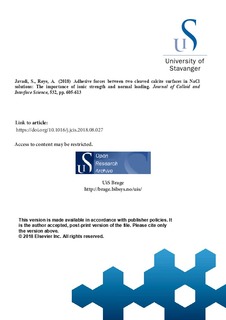Adhesive forces between two cleaved calcite surfaces in NaCl solutions: The importance of ionic strength and normal loading
Journal article, Peer reviewed
Accepted version
Permanent lenke
http://hdl.handle.net/11250/2594662Utgivelsesdato
2018-12-15Metadata
Vis full innførselSamlinger
Originalversjon
Shaghayegh , J. , Røyne, A. (2018) Adhesive forces between two cleaved calcite surfaces in NaCl solutions: The importance of ionic strength and normal loadin. Journal of Colloid and Interface Science. 532, pp. 605-613. 10.1016/j.jcis.2018.08.027Sammendrag
The mechanical strength of calcite bearing rocks is influenced by pore fluid chemistry due to the variation in nano-scale surface forces acting at the grain contacts or close to the fracture tips. The adhesion of two contacting surfaces, which affects the macroscopic strength of the material, is not only influenced by the fluid chemistry but also by the surface topography. In this paper, we use Atomic Force Microscope (AFM) to measure the interfacial forces between two freshly cleaved calcite surfaces in CaCO3-saturated solutions with varying NaCl concentration. We show that calcite contacts become stronger with increasing NaCl concentration (> 100 mM), as a result of progressively weaker secondary hydration and increasing attraction due to instantaneous ion-ion correlation. Moreover, we discuss the effect of normal applied force (Fn) and surface roughness on the measured adhesion forces (Fad). We show that the measured pull-off force (adhesion) is linearly correlated with the magnitude of Fn, where an increase in applied force results in increased adhesion. This is attributed to a larger number of contacting surface asperities and thus increase in real contact area and the contact-bond strength. We discuss that the possible variation in local topography at contacts, together with strong dependence on ionic strength of the solution, can explain the inconsistent behavior of calcite rocks in NaCl solutions.

